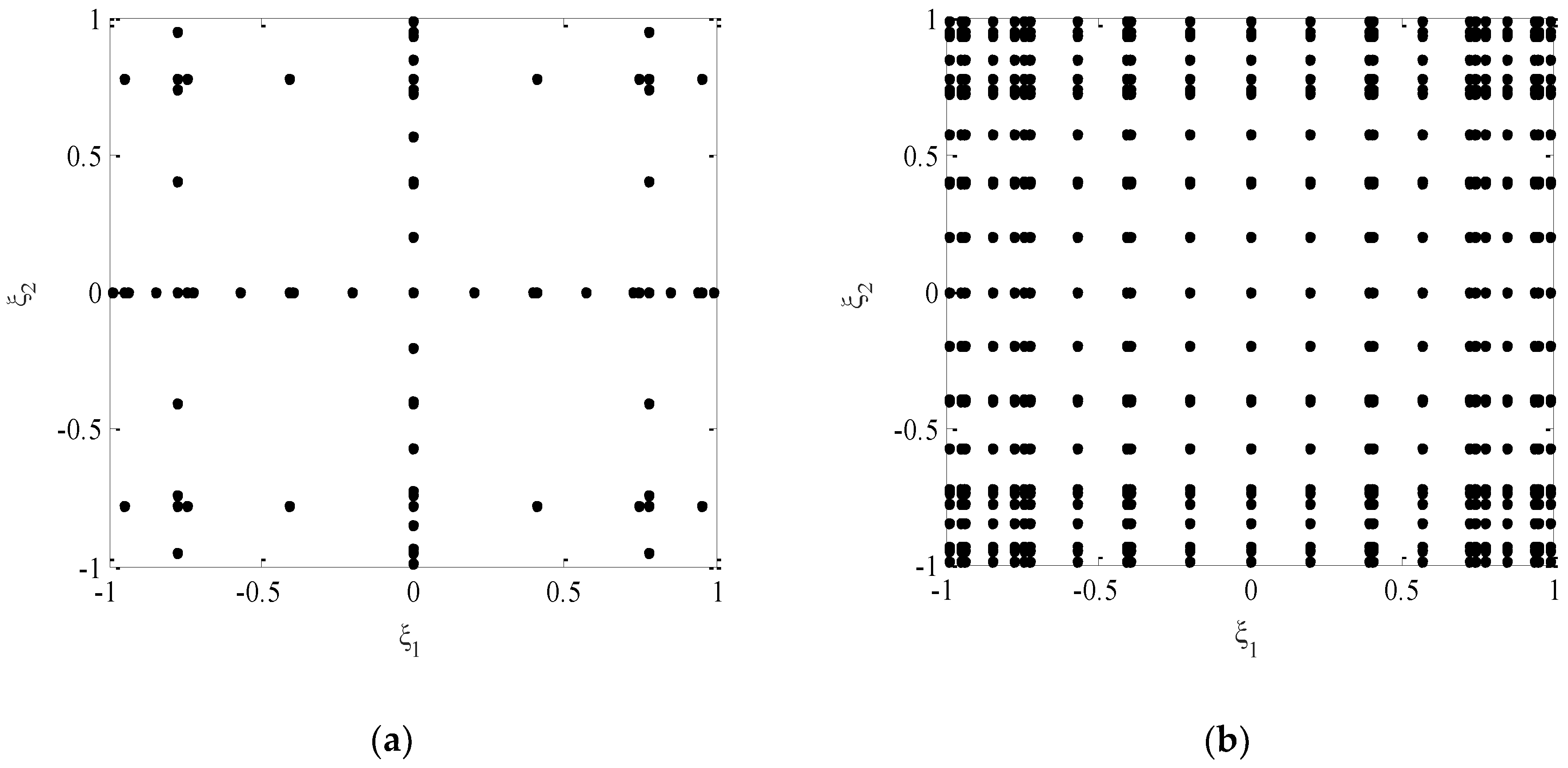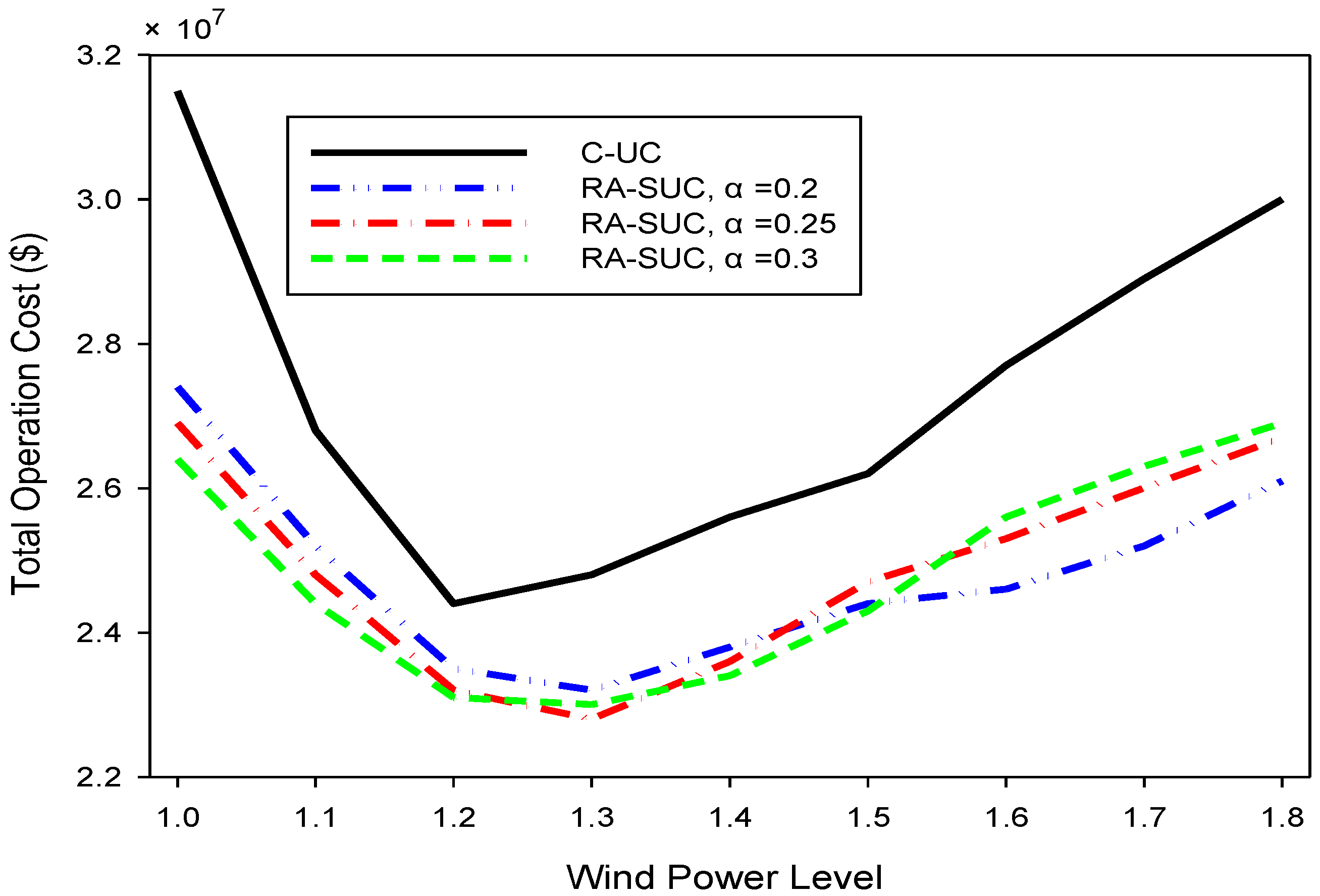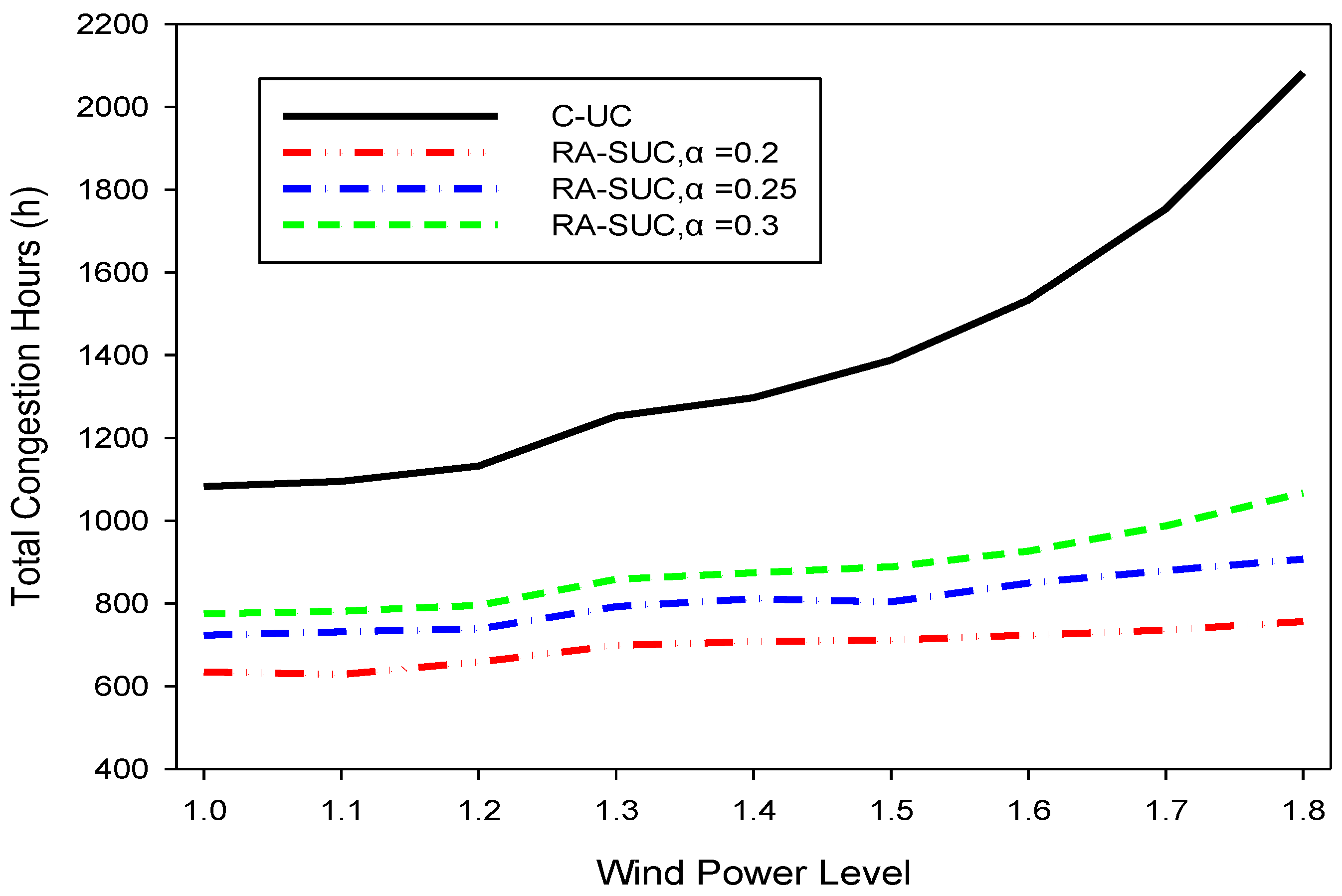Congestion Risk-Averse Stochastic Unit Commitment with Transmission Reserves in Wind-Thermal Power Systems
Abstract
Featured Application
Abstract
1. Introduction
- The risk of transmission congestion is formulated in the form of predictive transmission reserves, which is incorporated in the SUC framework to improve the operational flexibility and capability of facing unexpected wind power realizations.
- The transmission reserve requirements are dynamically quantified in the UC based on the probabilistic real-time line flow information, rather than using the deterministic way of assigning a predefined portion of total transmission capacity.
- The statistical features of line flows in response to the multi-correlated wind power uncertainty are systematically characterized in a probabilistic redispatch problem using the high-dimensional PCM, which avoids the complexity induced by numerous scenarios in the traditional MCS-based approaches.
2. Problem Formulation
2.1. Modeling Conditional Forecast Error for Multiple Wind Farms
2.2. Risk Averse Stochastic Unit Commitment with Transmission Reserves
- The Unit Constraints:
- The System Constraints:where , , , are the sets of generators, nodes, transmission lines and time periods, respectively; is the subset of generators at bus n; is the shut-down binary variable of generator g at time t; and are the minimum and maximum output levels of generator g; and are the ramp-down and ramp-up rates of generator g, and is the 10-min ramp rate. and are the minimum-down/ -up times of generator g. is the power flow limit for line l. and denote the net load and day-ahead wind power forecast at bus n and time t, respectively, with the reserve capacity coefficients and . is the shift factor which characterizes the contribution from bus n to power flow on line l.
3. Quantifying Transmission Reserve Requirements in Real-Time Dispatch
3.1. Basic Real-Time Dispatch Model with Corrective Measures
3.2. Probabilistic Collocation Method with Correlation Control
3.3. High Dimensionality and Sparse Grids
4. Discussion
5. Case Study
6. Conclusions
Author Contributions
Funding
Acknowledgments
Conflicts of Interest
Acronyms
| NWP | numerical weather prediction |
| ESS | energy storage systems |
| DR | demand response |
| FACTS | flexible AC transmission systems |
| UC | unit commitment |
| ED | economic dispatch |
| C-UC | conventional unit commitment |
| SUC | stochastic unit commitment |
| RA-SUC | risk-averse stochastic unit commitment |
| MC | Monte Carlo |
| MCS | Monte Carlo simulation |
| PCM | probabilistic collocation method |
| PCM-SG | probabilistic collocation method with sparse grids |
| MIP | mixed integer programming |
| probability density function | |
| CDF | cumulative probability function |
| VOWC | Value of Wind Curtailment |
| VOLL | Value of Lost Load |
| P-OPF | probabilistic optimal power flow |
| CP | collocation point |
| PEM | point estimate method |
| 2PEM | two-point estimate method |
| GQ | Gaussian quadrature |
References
- Hernández-Escobedo, Q.; Manzano-Agugliaro, F.; Zapata-Sierra, A. The wind power of Mexico. Renew. Sustain. Energy Rev. 2010, 14, 2830–2840. [Google Scholar] [CrossRef]
- Montoya, F.G.; Manzano-Agugliaro, F.; López-Márquez, S.; Hernández-Escobedo, Q.; Gil, C. Wind turbine selection for wind farm layout using multi-objective evolutionary algorithms. Expert Syst. Appl. 2014, 41, 6585–6595. [Google Scholar] [CrossRef]
- Dong, L.; Wang, L.; Khahro, S.F.; Gao, S.; Liao, X. Wind power day-ahead prediction with cluster analysis of NWP. Renew. Sustain. Energy Rev. 2016, 60, 1206–1212. [Google Scholar] [CrossRef]
- Andrade, J.R.; Bessa, R.J. Improving renewable energy forecasting with a grid of numerical weather predictions. IEEE Trans. Sustain. Energy 2017, 8, 1571–1580. [Google Scholar] [CrossRef]
- Drew, D.R.; Cannon, D.J.; Barlow, J.F.; Coker, P.J.; Frame, T.H.A. The importance of forecasting regional wind power ramping: A case study for the UK. Renew. Energy 2017, 114, 1201–1208. [Google Scholar] [CrossRef]
- Pappala, V.S.; Erlich, I.; Rohrig, K.; Dobschinski, J. A stochastic model for the optimal operation of a wind-thermal power system. IEEE Trans. Power Syst. 2009, 24, 940–950. [Google Scholar] [CrossRef]
- Choi, J.W.; Kim, M.K. Multi-Objective Optimization of Voltage-Stability Based on Congestion Management for Integrating Wind Power into the Electricity Market. Appl. Sci. 2017, 7, 573. [Google Scholar] [CrossRef]
- Bludszuweit, H.; Domínguez-Navarro, J.A.; Llombart, A. Statistical analysis of wind power forecast error. IEEE Trans. Power Syst. 2008, 23, 983–991. [Google Scholar] [CrossRef]
- Huang, Y.; Xu, Q.; Jiang, X.; Tong, Z.; Yang, Y. Modelling Correlated Forecast Error for Wind Power in Probabilistic Load Flow. Elektron. Elektrotech. 2017, 23, 61–66. [Google Scholar] [CrossRef]
- Pinson, P.; Kariniotakis, G. Conditional prediction intervals of wind power generation. IEEE Trans. Power Syst. 2010, 25, 1845–1856. [Google Scholar] [CrossRef]
- Lan, H.; Yin, H.; Wen, S.; Hong, Y.Y.; Yu, D.C.; Zhang, L. Electrical Energy Forecasting and Optimal Allocation of ESS in a Hybrid Wind-Diesel Power System. Appl. Sci. 2017, 7, 155. [Google Scholar] [CrossRef]
- Aghaei, J.; Alizadeh, M.I.; Siano, P.; Heidari, A. Contribution of emergency demand response programs in power system reliability. Energy 2016, 103, 688–696. [Google Scholar] [CrossRef]
- Nasri, A.; Conejo, A.J.; Kazempour, S.J.; Ghandhari, M. Minimizing wind power spillage using an OPF with FACTS devices. IEEE Trans. Power Syst. 2014, 29, 2150–2159. [Google Scholar] [CrossRef]
- Li, N.; Hedman, K.W. Economic assessment of energy storage in systems with high levels of renewable resources. IEEE Trans. Sustain. Energy 2015, 6, 1103–1111. [Google Scholar] [CrossRef]
- Henneaux, P.; Kirschen, D.S. Probabilistic security analysis of optimal transmission switching. IEEE Trans. Power Syst. 2016, 31, 508–517. [Google Scholar] [CrossRef]
- Moshari, A.; Ebrahimi, A.; Fotuhi-Firuzabad, M. Short-term impacts of DR programs on reliability of wind integrated power systems considering demand-side uncertainties. IEEE Trans. Power Syst. 2016, 31, 2481–2490. [Google Scholar] [CrossRef]
- Hreinsson, K.; Vrakopoulou, M.; Andersson, G. Stochastic security constrained unit commitment and non-spinning reserve allocation with performance guarantees. Int. J. Electr. Power. 2015, 72, 109–115. [Google Scholar] [CrossRef]
- Lee, T.Y. Optimal spinning reserve for a wind-thermal power system using EIPSO. IEEE Trans. Power Syst. 2007, 22, 1612–1621. [Google Scholar] [CrossRef]
- De, V.K.; Driesen, J. Dynamic operating reserve strategies for wind power integration. IET Renew. Power Gen. 2014, 8, 598–610. [Google Scholar]
- Papavasiliou, A.; Oren, S.S.; Rountree, B. Applying high performance computing to transmission-constrained stochastic unit commitment for renewable energy integration. IEEE Trans. Power Syst. 2015, 30, 1109–1120. [Google Scholar] [CrossRef]
- Bertsimas, D.; Litvinov, E.; Sun, X.A.; Zhao, J.; Zheng, T. Adaptive robust optimization for the security constrained unit commitment problem. IEEE Trans. Power Syst. 2013, 28, 52–63. [Google Scholar] [CrossRef]
- Xu, M.; Zhuan, X. Optimal planning for wind power capacity in an electric power system. Renew. Energy 2013, 53, 280–286. [Google Scholar] [CrossRef]
- Morshed, M.J.; Hmida, J.B.; Fekih, A. A probabilistic multi-objective approach for power flow optimization in hybrid wind-PV-PEV systems. Appl. Energy. 2018, 211, 1136–1149. [Google Scholar] [CrossRef]
- Morshed, M.J.; Asgharpour, A. Hybrid imperialist competitive-sequential quadratic programming (HIC-SQP) algorithm for solving economic load dispatch with incorporating stochastic wind power: A comparative study on heuristic optimization techniques. Energy Convers. Manage. 2014, 84, 30–40. [Google Scholar] [CrossRef]
- Wang, F.; Hedman, K.W. Dynamic reserve zones for day-ahead unit commitment with renewable resources. IEEE Trans. Power Syst. 2015, 30, 612–620. [Google Scholar] [CrossRef]
- Ye, H.; Ge, Y.; Shahidehpour, M.; Li, Z. Uncertainty marginal price, transmission reserve, and day-ahead market clearing with robust unit commitment. IEEE Trans. Power Syst. 2017, 32, 1782–1795. [Google Scholar] [CrossRef]
- Zhang, Z.S.; Sun, Y.Z.; Gao, D.W.; Lin, J.; Cheng, L. A versatile probability distribution model for wind power forecast errors and its application in economic dispatch. IEEE Trans. Power Syst. 2013, 28, 3114–3125. [Google Scholar] [CrossRef]
- Huang, Y.; Xu, Q.; Yang, Y.; Jiang, X.Q. Numerical method for probabilistic load flow computation with multiple correlated random variables. IET Renew. Power Gen. 2018, 12, 1295–1303. [Google Scholar] [CrossRef]
- Hashimoto, T. A method for solving optimal control problems subject to probabilistic affine state constraints for linear discrete-time uncertain systems. Int. J. Mech. Prod. Eng. 2015, 3, 6–10. [Google Scholar]
- Jiang, R.; Guan, Y.; Watson, J.P. Risk-averse stochastic unit commitment with incomplete information. IIE Trans. 2016, 48, 838–854. [Google Scholar] [CrossRef]
- Huang, Y.; Zheng, Q.P.; Wang, J. Two-stage stochastic unit commitment model including non-generation resources with conditional value-at-risk constraints. Electr. Power Syst. Res. 2014, 116, 427–438. [Google Scholar] [CrossRef]
- Gazijahani, F.S.; Salehi, J. Integrated DR and reconfiguration scheduling for optimal operation of microgrids using Hong’s point estimate method. Int. J. Electr. Power Energy Syst. 2018, 99, 481–492. [Google Scholar] [CrossRef]
- Zhang, X.F.; Pandey, M.D.; Zhang, Y.M. A numerical method for structural uncertainty response computation. Sci. China Technol. Sci. 2011, 54, 3347–3357. [Google Scholar] [CrossRef]
- Advanpix, L L C. Multiprecision Computing Toolbox for Matlab. 2006. Available online: https://www.advanpix.com/ (accessed on 6 July 2016).
- Lin, G.; Elizondo, M.; Lu, S.; Wan, X.L. Uncertainty Quantification in Dynamic Simulations of Large-scale Power System Models using the High-Order Probabilistic Collocation Method on Sparse Grids. Int. J. Uncert. Quant. 2014, 4, 185–204. [Google Scholar] [CrossRef]
- Othman, M.M.; Musirin, I. A novel approach to determine transmission reliability margin using parametric bootstrap technique. Int. J. Electr. Power. 2011, 33, 1666–1674. [Google Scholar] [CrossRef]
- NARI. [Online]. Available online: http://www.narigroup.com/ (accessed on 9 May 2018).
- Christie, R. Power System Test Archive. (University of Washington, 1999)[Online]. Available online: http://www.ee.washington.edu/research/pstca/ (accessed on 18 March 2014).
- CPLEX, V 12.1. User’s Manual for CPLEX. Int. Bus. Mach. Corp. 2009, 46, 157. Available online: ftp://public.dhe.ibm.com/software/websphere/ilog/docs/optimization/cplex/ps_usrmancplex.pdf (accessed on 10 September 2017).





| With Correlation | Without Correlation | ||||||||
|---|---|---|---|---|---|---|---|---|---|
| Case 1 | Case 2 | Case 3 | Case 4 | Case 1 | Case 2 | Case 3 | Case 4 | ||
| Total Cost [$/day] | RA-SUC | 53,784 | 45,748 | 52,574 | 45,983 | 52,313 | 45,022 | 49,468 | 45,537 |
| C-UC | 55,652 | 49,294 | 56,620 | 47,125 | 53,659 | 48,356 | 54,532 | 46,749 | |
| Wind Utilization Ratio [%] | RA-SUC | 88.41 | 93.74 | 90.53 | 96.93 | 89.28 | 93.82 | 90.47 | 98.10 |
| C-UC | 87.67 | 91.93 | 89.70 | 93.71 | 87.91 | 92.13 | 89.78 | 95.58 | |
| Load Serve Ratio [%] | RA-SUC | 95.26 | 98.21 | 94.87 | 99.83 | 95.24 | 98.21 | 95.18 | 99.85 |
| C-UC | 95.12 | 98.26 | 94.57 | 99.36 | 95.21 | 98.15 | 94.59 | 99.69 | |
| Spinning Reserves [MWh/day] | RA-SUC | 10,505 | 7186 | 9806 | 7458 | 11,002 | 7437 | 10,799 | 8062 |
| C-UC | 11,284 | 8849 | 10,892 | 9280 | 11,891 | 9166 | 11,680 | 9613 | |
© 2018 by the authors. Licensee MDPI, Basel, Switzerland. This article is an open access article distributed under the terms and conditions of the Creative Commons Attribution (CC BY) license (http://creativecommons.org/licenses/by/4.0/).
Share and Cite
Huang, Y.; Xu, Q.; Lin, G. Congestion Risk-Averse Stochastic Unit Commitment with Transmission Reserves in Wind-Thermal Power Systems. Appl. Sci. 2018, 8, 1726. https://doi.org/10.3390/app8101726
Huang Y, Xu Q, Lin G. Congestion Risk-Averse Stochastic Unit Commitment with Transmission Reserves in Wind-Thermal Power Systems. Applied Sciences. 2018; 8(10):1726. https://doi.org/10.3390/app8101726
Chicago/Turabian StyleHuang, Yu, Qingshan Xu, and Guang Lin. 2018. "Congestion Risk-Averse Stochastic Unit Commitment with Transmission Reserves in Wind-Thermal Power Systems" Applied Sciences 8, no. 10: 1726. https://doi.org/10.3390/app8101726
APA StyleHuang, Y., Xu, Q., & Lin, G. (2018). Congestion Risk-Averse Stochastic Unit Commitment with Transmission Reserves in Wind-Thermal Power Systems. Applied Sciences, 8(10), 1726. https://doi.org/10.3390/app8101726







